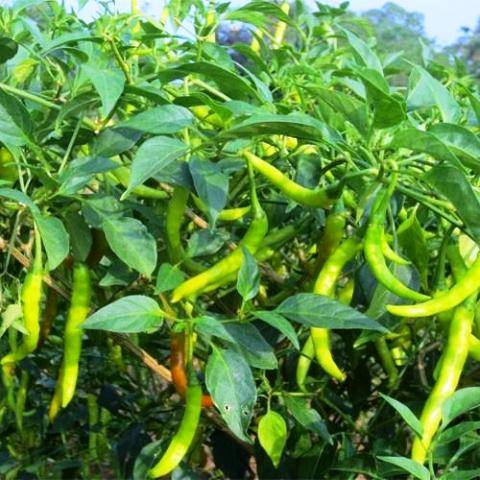
Chilli is a peppery fruit that is used in many dishes all over the world including India. Chilly is usually added as an ingredient in a food to make it spicy. At present, they are used both as an ingredient in food preparations as well as medicines. According to latest figures, India tops the chilli production list followed by China, Peru, Spain and Mexico. Indian chillies particularly the one that is grown in Guntur district of Andhra Pradesh is very famous for its pungency and color. There are some big sized chillies as well and they are called bell peppers.
Subscribe to our digital copies. Click here.
Chilli belongs to family Solanaceae and is botanically known as Capsicum annuum. It is a small, yearly shrub with a straight, branched shoot. It also has a tap root system with very simple leaves. The flowers of chilli are white in color. In India chilli is also called mirchi, lanka etc.
Climate requirement
Chilli is a tropical and sub-tropical plant that requires a blend of warm, humid or dry weather. At the growing stage it requires a warm and humid weather. Nevertheless, a dry weather is quite good for fruit maturity. Temperature between 20⁰ to 25⁰C is perfect for the growth of chilli. If the temperature goes above 37⁰C then the fruit development gets affected. Likewise in case of heavy rainfall the plant defoliates and begins decomposing. But, in case of low moisture conditions during the fruiting phase, the bud does not grow properly. In short, a high temperature or moderately low humidity level could lead to deflowering.

Soil requirement
It is important to know that chillies need good moisture for growth. Black soil which keeps hold of moisture is perfect if they are grown as rainfed crops. Under irrigated conditions, they need well-drained filthy loam with rich organic content. Chillies can also be grown in deltaic soil under irrigated conditions. In Uttarakhand or other hilly regions, soil is mixed with coarse sand and gravel before starting chilli cultivation.
A neutral soil pH in the range of 6.5 and 7.5 is ideal for chilli cultivation.
Right Season
Chilli can be cultivated as Kharif and Rabi crop. Additionally it can be planted at anytime. Sowing months for Kharif crop are May to June while for Rabi crops they are September to October. And if you plant them as summer crops then January and February are good.
Watering
Chillies cannot withstand a lot of water hence heavy rain and stagnated water could spoil the plants. In case of irrigated crops, you should water only when it is essential. Continuous watering would lead to shedding of flowers and a burst of vegetative growth. Climatic conditions and soil type also decides the amount of water to be irrigated and in what frequency.

Planting Material
You need to know that chillies are propagated from the seeds. So you must choose disease- free and good quality seeds at the time of cultivation. Here are some of the common varieties used for commercial chilli cultivation:
Jwala - is grown in parts of Gujarat
Kanthari – is grown in Kerala and some parts of Tamil Nadu
Kashmiri Chilli - North Indian states like Jammu-Kashmir, Himachal Pradesh
Madhya Pradesh GT Sannam - It is cultivated in Indore, Chikli, Elachpur and Malkapur areas of Madhya Pradesh
Bhagya Lakshmi - is grown in irrigated areas of Andhra Pradesh
TNAU Hybrid Chilli Co1 – it is developed by TNAU, Coimbatore
Land preparation
The land for chilli cultivation is ploughed at least 2 to 3 times to bring it to a fine tilth. Unwanted materials present in the soil like gravel, stones must be removed. If you are sowing the seeds directly in the soil then it must be carried out along with the last ploughing cycle. During ploughing, you need to sterilize the soil properly so that diseases affecting the plants can be checked.
Sowing
The seeds of chillies should never be pre-treated with chemicals. Instead they must be treated with herbal fungicides. 80 grams of seeds will be needed for sowing in one acre of land. Seeds are treated with Pseudomonas fluorescens first and then mixed with Azospirillum. Afterwards it is shade dried for half hour.
Chilli seeds are generally grown in nurseries and then the seedlings are transplanted. After sowing, the seeds must be properly covered with coco peat and watered daily till it starts germinating. You can transplant the seedlings once they are 35 days old.

Transplanting
Before transplanting, the seedlings must be dipped in 0.5 percent Pseudomonas fluorescens solution for at least half an hour. Now they are ready to be transplanted in the main field. The intercrop distance must be maintained at 45 cm during plantation.
Intercropping
Chillies can be intercropped at few places with the onions in paired rows. In simple words - two rows of chillies can be followed by one row of onion. This helps in weed control and brings additional income to farmers.
Pest Management
Some of the major pests of chilli farming are thrips, nematodes, pod borers, grubs, aphids, mites, etc. Hence you need to ensure that only well-rotted manure is used. Also intercropping with onions would help avoid pest attack. You can use neem Seed Kernel Extract for controlling thrips and mites. Likewise, installing pheromone traps help control fruit borers.
Harvesting
Chilli harvesting is done as per the planned use of chillies. If you want to make chilli powders and dry chilli, the fruits are harvested when the chilli becomes dark red in color. And then the green fruit is taken out for preparing chilli pickles. Also make sure you pluck the ripe fruits at regular intervals.
Hence, this is all about how to do chilli cultivation…












